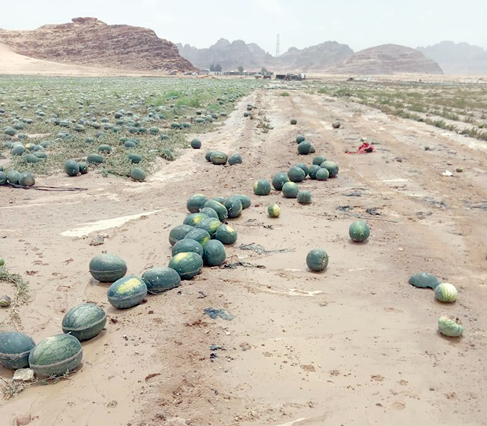You are here
Waleh Dam runs dry as farmers appeal for gov’t intervention
By Batool Ghaith - Sep 23,2021 - Last updated at Sep 23,2021
AMMAN — The Waleh Dam, built in 2003 with a storage capacity of 9 million cubic metres, is now dry due to the decrease in precipitation and the evaporation of water by about 9,000 cubic metes per day, as a result of high temperatures, according to the Jordan News Agency, Petra.
Farmers in Madaba appealed to the concerned authorities to save their agricultural crops, including many vegetables and fruit trees, which are threatened by the depletion of water in the Waleh Dam, Petra reported.
The Jordan Valley Authority (JVA) was unavailable to comment despite multiple attempts from The Jordan Times.
“Approximately 2,000 acres, planted with vegetables and fruit trees, and dozens of farmers and families who live off of these farms are suffering great losses now due to the crisis. The crops are in dire need of irrigation to maintain their growth, especially as the harvest time approaches,” Secretary General of the Jordanian Farmers Union (JFU) Mahmoud Oran told The Jordan Times during a phone interview on Wednesday.
All environmental plans must be reviewed to suit the climatic changes happening around the world, not only Jordan, Oran said.
“We have repeatedly encouraged and warned the concerned authorities to work out a clearer strategy to deal with environmental issues in Jordan, especially water harvesting, which is important for maintaining food security in the long run,” Oran added.
Oran noted that the last dam built for water harvesting was Al Wehda Dam, built in 2007.
“The average annual rainfall in Jordan is approximately 10-12 billion cubic metres, but our water harvest rate is only 500 million cubic metres. Meanwhile, the water loss is approximately 9 billion cubic metres, which is too much,” he said.
According to Oran, the high temperatures and recent low rainfall rates are the main reasons behind the dryness of the dam.
He added that due to the extremely high temperatures, the crops have required even more irrigation recently.
“The meteorological department can predict how the rainfall season will be, which should be taken into consideration by both the authorities and farmers to know how much crops to plant and to harvest water for the summer,” he continued.
Oran called on the concerned authorities to try to find a useful way for farmers to use the wells located in Waleh Dam area and to study the possibility of expanding the dam.
“The vegetable and fruit trees harvested in the dam area are not planted in other areas, such as lemon and guava. This is why we need to protect the crops, as losing them will affect prices and food security,” Oran said.
Related Articles
AMMAN — The recent rainfall has filled the Kingdom’s 14 major dams with four million cubic metres (4mcm) of water, as of Monday morning, acc
Two million cubic metres (mcm) of water entered the country’s 10 major dams over the past few days, raising storage levels to 65.54 per cent of their total capacity of 325mcm, officials said on Saturday.
AMMAN — Farmers are reporting “extensive damages” following the unseasonal heavy rainfall accompanied by hail on Monday, according to Direct
















